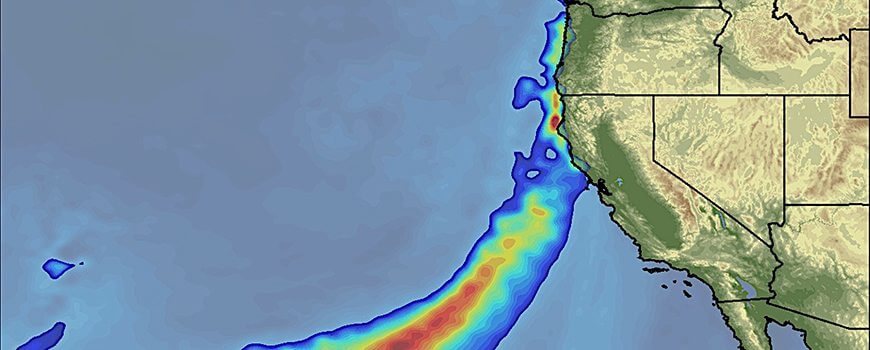Two recently published studies investigating past and future precipitation in California demonstrate that the state is experiencing an increasingly volatile precipitation regime, as rain-heavy winter storms known as “atmospheric rivers” become increasingly intense, and dry periods between storms grow longer. This makes for more variability in water resources from year to year, with both droughts and floods becoming more likely as seen recently when historic drought was followed by a record wet year.
The research team behind the two studies includes Alexander Gershunov, a research meteorologist at Scripps Institution of Oceanography at the University of California San Diego. He said that the combined results of these two papers provide “more nuanced” information about the changing climate of California than scientists had before. And it’s not all bad news.
“We expect to have a gradual change in the way precipitation is delivered that makes management of water resources and related issues more challenging,” Gershunov said, “But at least we are probably not running out of water in the long term. That’s the water delivery perspective. Increasing temperature, however, is a complicating factor that is converting snow to rain and increasing evaporation, while also increasing demand for water.”
In the first paper, published in the journal Geophysical Research Letters (GRL), Gershunov, Scripps postdoctoral researcher Tamara Shulgina, a, and Marty Ralph, a research meteorologist and director of the Center for Western Weather and Water Extremes at Scripps, analyzed seventy years of historical vapor transport and precipitation data to create a catalog of atmospheric river behavior along the West Coast of North America. Atmospheric rivers are concentrated flows of water vapor, driven by strong winds, that can deliver intense amounts of precipitation to coastal zones and beyond.
“Atmospheric rivers are important because they are the meteorological causes of the most extreme precipitation events along the West Coast,” Gershunov said.
Atmospheric rivers produce 40 to 50 percent of the annual precipitation in California in some years, and they can be the determining factor for the state’s water supply. This past winter 2017, California experienced over thirty atmospheric rivers, three of which were categorized as “extreme,” breaking precipitation records and causing serious flooding in Northern California. The inundation was unprecedented in the 70-year record, causing an unanticipated end to a historic California drought.
The catalog of atmospheric river history along the West Coast that Gershunov and his coauthors created shows a long-term trend of increasing water vapor transport onto the West Coast that is associated with Pacific sea surface warming. It also provides clues as to how scientists could use the climate variability patterns identified by Gershunov and his co-authors to forecast atmospheric river activity at seasonal timescales.
In the second paper, published in Scientific Reports, Scripps postdoctoral scholar Suraj Polade, Gershunov, Scripps climate scientist Dan Cayan, and coauthors looked to the future instead of the past, using global climate models to predict how climate change will affect precipitation in California and other Mediterranean climate regions. Mediterranean climate regions are special, because they sit between subtropical and mid-latitude climate zones. They generally have very dry summers and rely on winter storms for the majority of their precipitation.
When the researchers looked at projected future climate scenarios for a warmer planet using thirty climate models, they see Mediterranean climate regions projected to become drier, because the subtropical belt is expanding and precipitation is becoming less frequent. But California is different — mainly because of the increasing intensity of the most extreme precipitation events, which are known to be associated with atmospheric rivers — as Gershunov and coauthors observed in the GRL paper.
“Other regions with Mediterranean climates are projected to become drier compared to past conditions. But in California, although it’s not necessarily becoming wetter, the regime in which the precipitation is delivered is projected to change,” Gershunov said. “Rainfall in a warmer future will be delivered in less frequent but more intense events.”
Gershunov said the weather pattern of the past few years, when California has experienced historic drought followed by record rainfall, mostly delivered via atmospheric rivers, “exemplifies the kind of volatility we expect for the future.”
Water resources in California, especially Southern California, are already more variable from year to year than anywhere else in the U.S.
“It rarely happens that we get near-average rainfall for a year, we typically get deficient rainfall or excessive rainfall,” Gershunov said. Looking at the results across thirty climate models, Gershunov and coauthors found that this interannual variability is expected to become even more extreme as the climate warms. In addition to making water management and flood protection more challenging, the long dry periods between storms allow more time for toxins and pollutants to accumulate on the land surface, “meaning that more toxic runoff goes out into the ocean, and affects coastal ecosystems and probably also human health,” Gershunov said.
This work was funded by the Department of the Interior via the Southwest Climate Science Center and the U.S. Bureau of Reclamation, by the California Department of Water Resources, and NOAA’s California and Nevada Applications Program.

